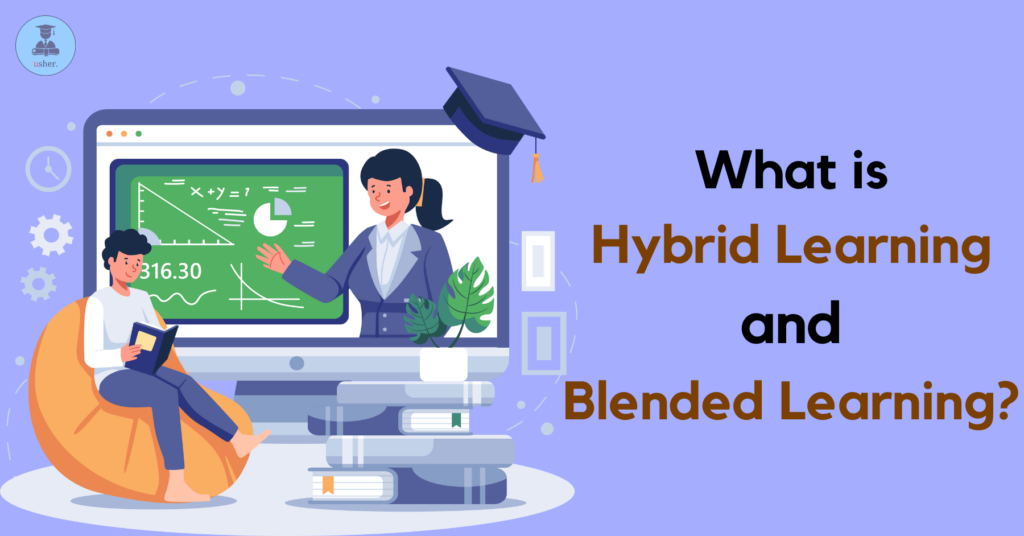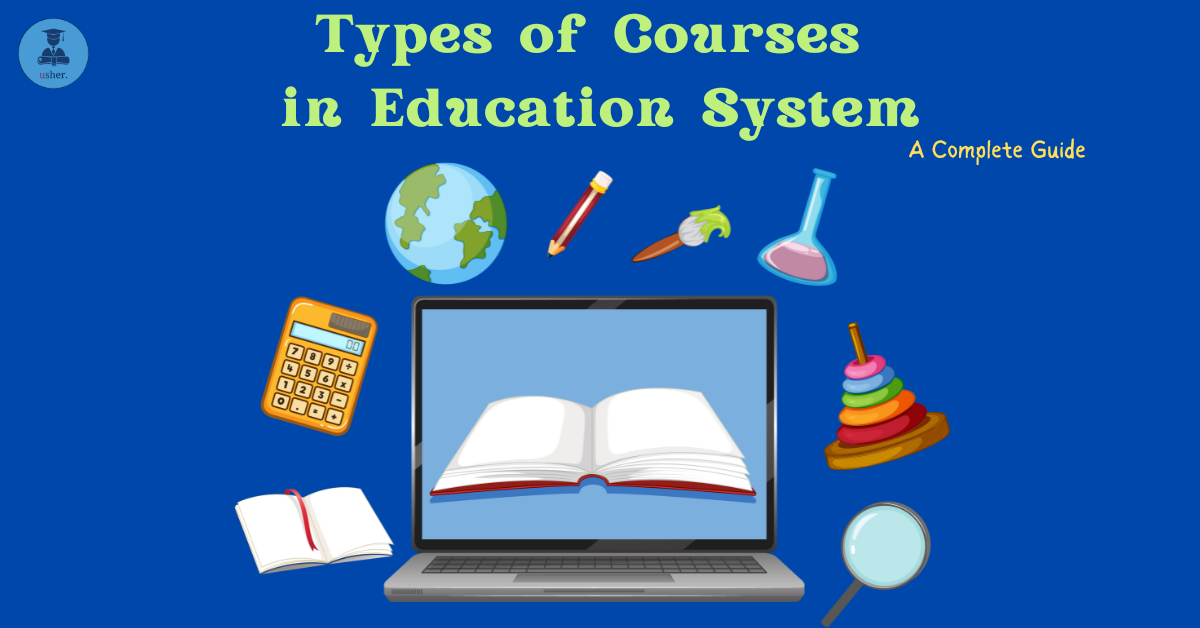A wide variety of educational approaches are emerging in this day and age with regard to modern education. Schools are incorporating technology into their curricula and adapting to new developments. More creative and adaptable approaches to education have replaced traditional methods. These approaches combine the best of both worlds, allowing students to have face-to-face interactions with teachers while also utilising technology for a more personalised learning experience.
Before going further, let us look at different types of learning methods.
Types of Learning Methodologies
Face-to-face learning
This method involves direct interaction between students and teachers in a physical classroom setting. It allows for immediate feedback, clarification, and the opportunity for students to engage in discussions and collaborative activities with their peers.
Online Learning
This method involves completing a course or study online via the internet and tools. It uses digital platforms and resources to deliver educational content and facilitate communication between students and teachers.
Hybrid Learning
This method involves both face-to-face learning and online learning. Students have the flexibility to complete some of their coursework online while still having the opportunity for in-person instruction and interaction with their peers and teachers.
Blended Learning
This method involves the use of technology and tools in classrooms. Teachers incorporate digital resources, such as online simulations or interactive whiteboards, to enhance traditional learning methods.
Now we know what hybrid and blended learning are, don’t we? Let us illustrate that with an example.
There is a 9th-grade boy called Rohit. His school gave him two options to complete his academics. One, he can come to school and attend the classes. Two, he can join the classes using the school's online portal from home. The timing for coming to the classroom or signing up for classes on the portal would be the same, as would the teachers; in essence, you would be attending live classes either in the classroom or from home. This is called the hybrid model of learning.
In a completely different scenario, Rohit's school decides to change the way teachers teach. They provide tablets to Rohit and his friends with complete access to the school's e-learning portal. Now that Rohit has access to pre-lesson materials online, teachers can conduct interactive, multi-modal classes in the classroom. With this new approach, Rohit and his friends can access educational materials and lessons anytime and anywhere. They can learn at their own pace and have the flexibility to review or revisit topics whenever needed. This is called the blended model of learning. We incorporate the use of technology into the standard classroom style of learning.
It is now crystal clear what hybrid learning and blended learning are, as well as their respective differences.
Let’s look at what their definitions are.
What is Blended Learning?
Blended learning is the integration of technology into face-to-face type of learning. It is a modern approach to education that combines the benefits of online and in-person instruction.
With blended learning, students have the flexibility to access educational materials and resources online, while also engaging in interactive activities and discussions with their classmates and teachers in a physical classroom setting. This approach allows for personalised learning experiences, as students can progress at their own pace and receive immediate feedback through digital platforms.
What is Hybrid Learning?
Hybrid learning is an innovative educational approach that combines the advantages of online and in-person instruction. It involves a mix of virtual and face-to-face learning experiences, providing students with the flexibility to access education online while also participating in interactive activities and discussions in a physical classroom.
Benefits of Hybrid and Blended Learning
The benefits of blended learning and hybrid learning are nearly identical, and both contribute to increased student participation and engagement.
- Both blended and hybrid learning models provide students with flexibility in terms of when and where they access course materials and complete assignments. This flexibility can accommodate varying learning schedules and preferences.
- Teachers can tailor instruction to meet individual student needs more effectively by utilizing data and insights gathered from online assessments and performance metrics. This personalization can lead to improved learning outcomes.
- Students have access to a wide range of resources, including digital textbooks, multimedia content, simulations, and interactive tools. These resources can enhance the learning experience and support a variety of learning styles.
- The combination of in-person and online resources and activities can make learning more engaging and interactive, promoting active participation and critical thinking.
- Both models allow educators to use data and analytics to inform their teaching practices, helping them identify areas where students may need additional support or challenges.
- Blended and hybrid learning can incorporate both synchronous (real-time) and asynchronous (self-paced) learning, catering to diverse learning preferences and schedules.
- These approaches can be scaled to accommodate different educational levels and institutions, making them adaptable for various student populations and settings.
- When designed with accessibility in mind, both blended and hybrid learning can be more inclusive for students with disabilities or diverse learning needs.
- Blended and hybrid learning models can equip students with digital literacy skills, which are increasingly essential in today’s technology-driven workplace.
- For higher education and professional development, these models can lead to cost savings by reducing commuting and material costs.
Are Hybrid Learning and Blended Learning the same?
You could say that they are nearly identical, with a few significant exceptions. On a broader scale, blended learning can also be considered a subset of hybrid learning.
The key differences between hybrid and blended learning are:
Location
Hybrid Learning: This type of learning typically places a strong emphasis on the classroom setting. The goal of a hybrid approach is to intentionally combine online and in-person learning, emphasizing the value of students’ physical presence in a classroom while supplementing it with online learning resources.
Blended Learning: Contrarily, blended learning frequently emphasizes the mixing of online and in-person components without necessarily calling for a rigid separation between the two. It draws attention to how well different learning modes are integrated.
Flexibility
Hybrid Learning: The degree of flexibility in hybrid learning models varies. Some might have set times for both the online and in-person components, which could reduce their flexibility.
Blended Learning: Students can participate in a combination of in-person meetings and synchronous and asynchronous online activities using blended learning, which frequently offers more flexibility. It can be helpful to have this flexibility to accommodate various schedules and learning styles.
Implementation
Hybrid Learning: In certain circumstances, a more rigid division between in-person and online instruction may be implemented, designating particular days or times for each method.
Blended learning: This term frequently refers to a more integrated method in which online and in-person components are intentionally created to work in concert with one another.
Therefore, we understand that blended learning is more advanced and more centred on creating a seamless and cohesive learning experience for students. It allows for flexibility in terms of when and where learning takes place, while still providing opportunities for face-to-face interaction and hands-on activities.
Implementation of Hybrid and Blended Learning in India
India has gained momentum in recent years. Many educational institutions have recognized the benefits of combining online and in-person learning to cater to diverse student needs and enhance the overall learning experience. This approach has been particularly effective in addressing geographical barriers and increasing access to quality education for students across the country.
India has undergone a significant shift towards hybrid learning since the arrival of COVID-19. This shift to hybrid learning has allowed educational institutions in India to adapt quickly and continue providing education amidst the pandemic. By leveraging technology, students can now access online resources and participate in virtual classrooms. This flexible approach has not only ensured continuity in education but also fostered innovation in teaching methods and increased collaboration among students and educators.
Yet, there are problems that have arisen with the shift to hybrid learning. One major challenge is the lack of access to technology and internet connectivity, particularly in rural areas. This has resulted in a digital divide, where some students are unable to fully participate in online classes. India still has a long way to go in terms of bridging this gap and ensuring equal access to education for all.
Blended education has not been much introduced or implemented in India on a larger scale. However, it has the potential to address some of the challenges faced with hybrid learning. This is primarily due to the lack of infrastructure and resources required for effective implementation.
The Indian education system needs proper training and support for teachers to adapt to this new mode of teaching. With the increasing recognition of the benefits of blended learning, efforts are being made to gradually introduce it in schools and colleges across the country.
The National Education Policy 2020 (NEP 2020) of India has proposed the implementation of blended learning as a way to improve the quality of education and increase access to it.




